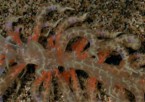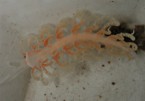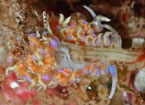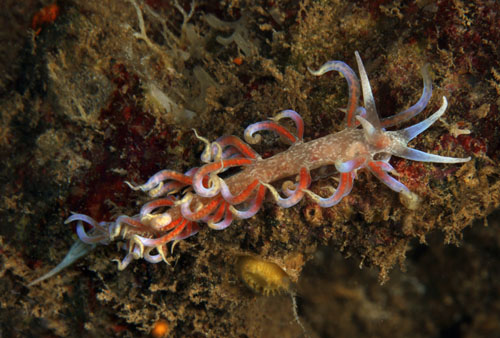| Home |
| Acknowledgments |
| Conventions |
| Glossary |
| Maps |
| References |
| Links |
| Articles |
| Thumbnails |
| Species
list |
| Family |
| Next
species |
Additional Photos

head detail

cerata detail

underside

side

pale

resting

laying eggs

food
_______________
GALLERY

Phyllodesmium poindimiei (Risbec, 1928)

| Maximum size: about 50 mm. Identification: This translucent species has a very slender, elongate body with cerata that are cylindrical, smooth and curved at the tips. Branches of the digestive gland extend to the very apex of each ceras and have simple side branches. Each one is typically orange at the base becoming yellow near the tip. There is usually blue iridescence subapically on the cerata, rhinophores and cephalic tentacles while some animals have a few cloudy white patches on the surface of their cerata. The rhinophores are long, smooth and roughly equal in length to the cephalic tentacles. Natural history: Phyllodesmium poindimiei is moderately common on its host octocoral, Carijoa sp., where it is extremely well camouflaged. It has been found in moderately protected, shaded habitats from 6-20 m (20-65 ft). It's primarily nocturnal, concealing itself near the bases of the octocoral during the day and crawling out to the tips of the plumes at night. Since its food octocoral is known to be an introduced species, it is also probably introduced. (Note 1) It autotomizes its cerata readily. (Note 2) Wagner, et. al. (2009) reported that it lays a white spiral egg mass that hatches in 5-6 days in the laboratory and that it is preyed on by the swimming crab Thalamita integra. Distribution: Big Island, Maui and Oahu: widely distributed in the Indo-Pacific. Taxonomic notes: It was named for the municipality Poindimie in New Caledonia from which it was originally described and was first recorded in Hawaii from Mala Wharf, Maui by CP on Oct. 15, 1995. Photo: PF: about 40 mm: near Carijoa sp.; St. Anthony wreck, Maui; May 20, 2011. Observations and comments: Note 1: The octocoral Carijoa sp. is one of almost 300 non-native marine invertebrates known to have colonized Hawaii and is considered one of the most invasive. It has spread rapidly during the 35 or more years since its introduction and is now considered a threat to black corals and their symbionts as well as to Hawaii’s precious coral industry. Phyllodesmium poindimiei is one of its few known predators. Note 2: In one case, autotomized cerata continued to move for over three hours after they were dropped. Perhaps, this serves to distract potential predators? |
| Thumbnails |
Species
list |
Family | Next species | Top |